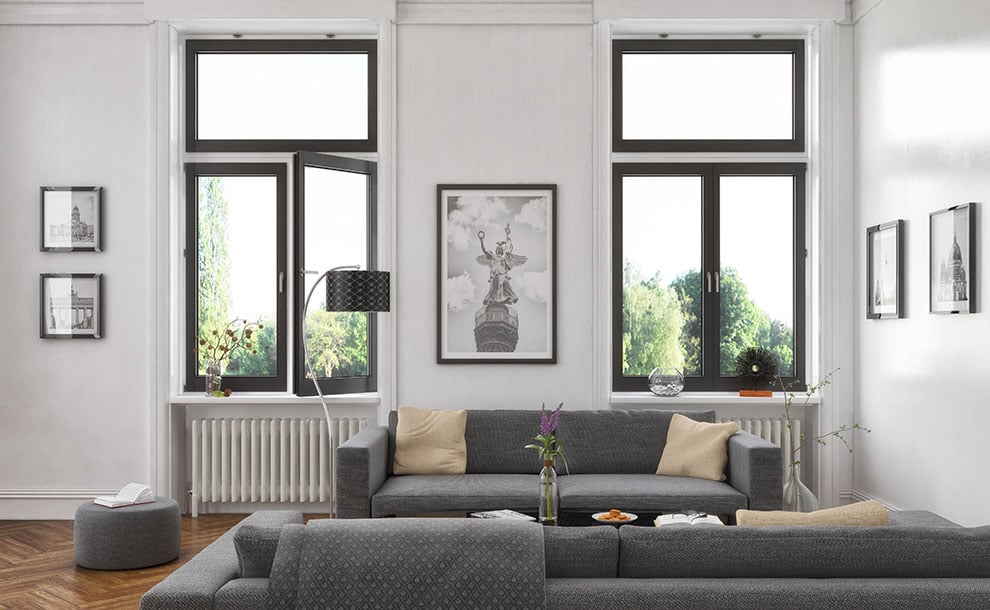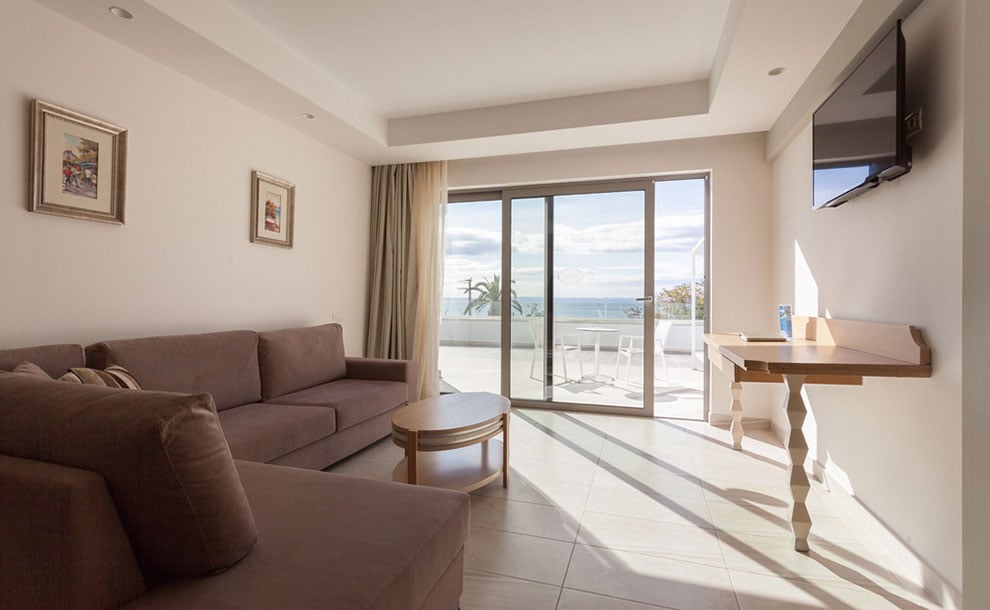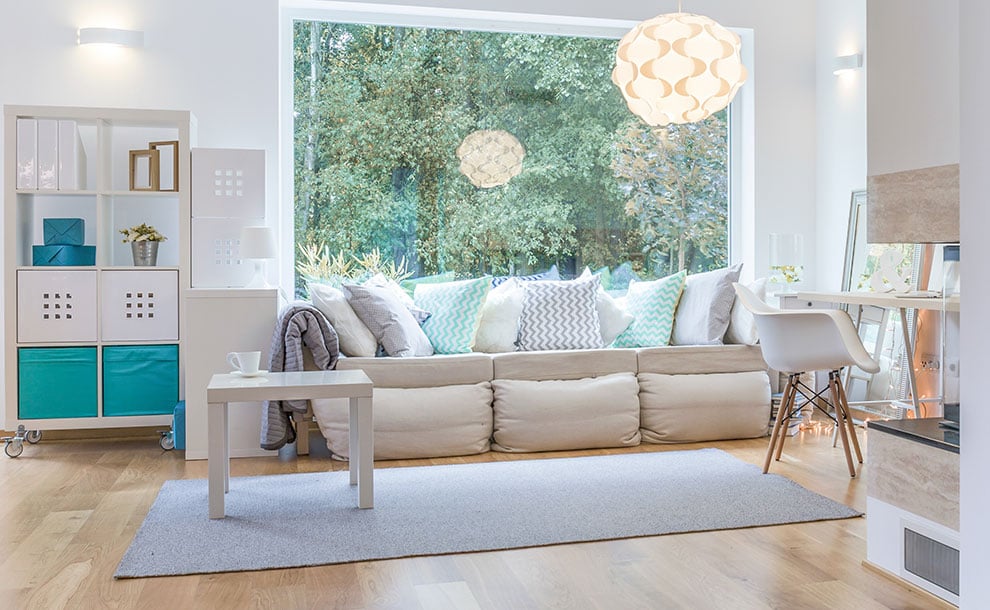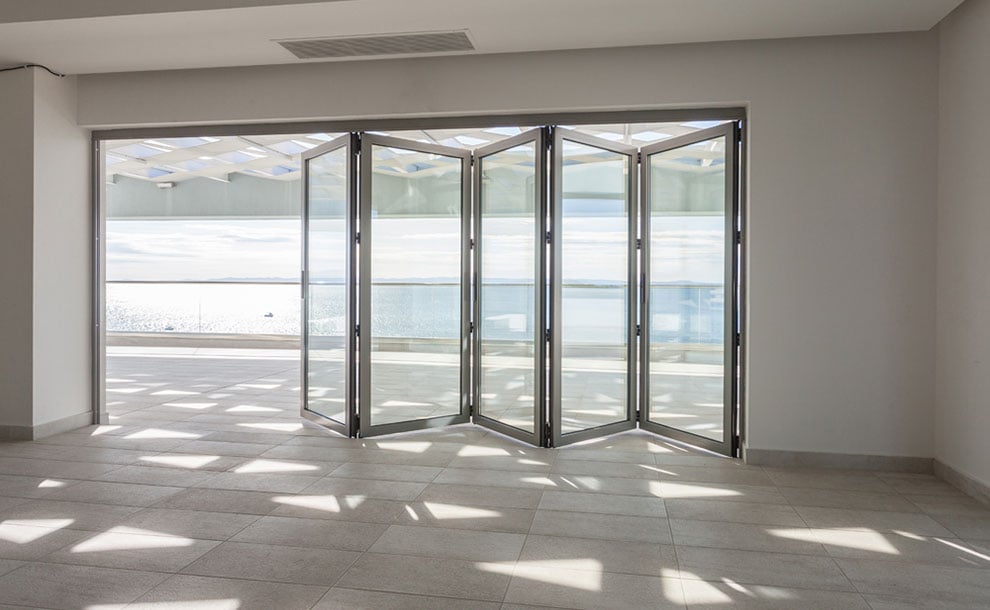Casement Windows
Casement windows provide excellent levels of thermal insulation, sound insulation and tightness against air and water. However, they cannot cover large spans, over 2,00 m wide, even in the case of a double-leaf patio door. They also require the appropriate amount of space inside, so that the window or door can be opened without barriers.
ALUMIL offers a wide range of various hinged windows and patio doors:
- Opening inwards with or without a tilt function
- Opening outwards
- Top hung windows (that open outwardly from the bottom)
- Vertical or horizontal pivot windows
- Combination of sliding and hinged window with a deflection mechanism
Pivot Windows
Pivot windows are a suitable replacement window choice for homeowners who wish to include maximum ventilation in a room. The pivot window sash is secured to the window frame by a pivot mechanism, located mid-way along opposing window sashes which attach the window sash to the frame. The window can then swing inwards either horizontally or vertically, depending on the location of the pivot mechanisms. This leaves the sash suspended in the middle of the frame, held by the opposing pivots. A replacement pivot window provides a window frame option that can open completely.
Sliding Windows
Sliding windows and doors are a very good option in case you need to cover spans which have a width larger than 1.70 m. Moreover, sliding windows are the ideal option when you have limited space around your window. Also, for large spans you can use a technologically superior lift & slide system that is much easier to slide and provides an excellent tightness against air and water, thanks to the special lift mechanism that raises the sash, allowing its rollers to glide smoothly on the rail of the frame.
Modern sliding windows and doors have come a long way and provide reliable solutions, with excellent functionality.
ALUMIL offers a wide variety of sliding or lift & slide windows and doors:
- Horizontal sliding windows – In which multiple sliding windows stand next to each other on separate sliding tracks.
- Meeting stile windows – In which two sliding windows stand on the same sliding track and are locked at their connection point in the middle.
- Pocket windows – Usually, one or two sliding windows which when opened are hidden into to the wall.
- Corner windows – Constructions in which two sliding windows make a right angle (90o) and are locked at their connection point in the corner.
Fixed Windows
Fixed windows are fixed to the wall without any closing or opening operation. In general, they are provided to transmit the light into the room. Fully glazed shutters are fixed to the window frame. This type of window is used in situations where light or vision alone is needed as no ventilation is possible through fixed window.
Bi-folding Windows
If there are very large spans and you want easy access to exterior areas, you can choose a folding door solution. Its main advantage is the full or partial folding of the sashes onto the side of the frame. This solution is usually preferred in professional spaces, as restaurants and cafes or in large houses, providing full freedom of movement and easy access.
To sum up, a vast amount of solutions is provided and that is why you should be careful with some details regarding each particular space. Generally, in order to choose the right type of window or door, you should take into account the following:
- The span that you would like to cover (length, width, height)
- Climate conditions of the exterior environment.
- The layout of the house and its furniture
- The access to the window or door, so as to open/close it as well as to be able to clean it inside and outside.
- The level of security you want to achieve.
Finally, having your safety and better quality of life in mind, all windows and doors can optionally be combined with insect screens, shutters and rolling shutters. ALUMIL offers a wide product range which ensures that you will find the solution that corresponds perfectly to your needs.
Design
Design for windows and doors has evolved so much that it can truly change the look of your space. The main trend nowadays is minimal design, what we call “less is more”. Minimal design aims at maximizing your field of view and consequently the daylight intake, so as to improve your quality of life.
ALUMIL’s products are designed in accordance with the latest design trends and have:
- Straight and minimal lines
- Ergonomic handles of high aesthetics and in various colors
- Concealed hinges
- Concealed sashes in order to minimize the visible aluminium
- Fames hidden inside the walls
- Narrow interlocking profiles for uninterrupted extensive glazing surfaces
- Low thresholds which provide easy access to the elderly, children and people with special needs according to European standards.
Examining the thermal insulation of a window or door
The type of a window or door affects the level of its thermal insulation. Thus, as mentioned above, hinged windows typically offer higher thermal insulation than sliding windows, as their design allows for higher sealing thanks to the insulating gaskets placed around the window leaf and the frame. For the same reason, i.e. the tightness level, a double leaf sliding window in which one leaf is sliding and the other fixed, offers greater thermal insulation than a corresponding one in which both leaves are sliding.
However, in order to be sure that the window we choose has a high level of thermal insulation, we should consider two key indicators: the Uf -value and the Uw-value.
The Uf indicates the thermal insulation level of the window without the glass panel, so it measures only the thermal loss of the frame and the leaf. Through the Uf we can directly compare two different frames and make useful conclusions about the level of the thermal insulation they offer. Though, in order to come to a final conclusion, we should check the Uw-value, which measures the thermal losses of a window as a whole, including the glass panel. Considering the fact that glass represents usually 70% -80% of the total surface of a window, it is obvious that the Uw indicator is crucial regarding the thermal insulation of a window.
For example, a simple non-insulated aluminium window with an energy efficient glass, can have a thermal insulation level similar to another more expensive thermally insulated aluminium window which does not include an energy efficient glass panel. So, we have to pay attention on both indicators, but give more emphasis on the Uw which is in fact the final thermal insulation of the window. Note that in entrance doors the corresponding indicator is called Ud and measures the level of thermal insulation of the door combined with the applied panel.
Last but not least, the Ug indicator determines the thermal insulation of the glass panel alone. In particular, the Uf-value combined with the Ug-value lead us to the final Uw-value (for windows/ balcony doors) or Ud-value (for entance doors).
It is important to remember that all of the above indicators measure thermal losses, which is why they are also called thermal transmittance indicators. The lower the thermal loss, the greater the thermal insulation of the tested windows or doors. Therefore, the lower the value of Uf, Ug, Uw and Ud, the higher energy efficiency will your windows and doors have. For example, a sliding door with Uw =1,6 W/m2K will offer higher thermal insulation than a sliding door with Uw =1,9 W/m2K. Finally, we should stress that Uw and Ud should always be calculated and compared for specific frame dimensions.







